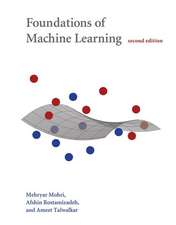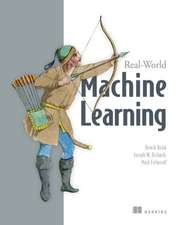Human-Computer Interaction. Theory, Methods and Tools: Thematic Area, HCI 2021, Held as Part of the 23rd HCI International Conference, HCII 2021, Virtual Event, July 24–29, 2021, Proceedings, Part I: Lecture Notes in Computer Science, cartea 12762
Editat de Masaaki Kurosuen Limba Engleză Paperback – 18 iun 2021
The 139 papers included in this HCI 2021 proceedings were organized in topical sections as follows:
Part I, Theory, Methods and Tools: HCI theory, education and practice; UX evaluation methods, techniques and tools; emotional and persuasive design; and emotions and cognition in HCI
Part II, Interaction Techniques and Novel Applications: Novel interaction techniques; human-robot interaction; digital wellbeing; and HCI in surgery Part III, Design and User Experience Case Studies: Design case studies; user experience and technology acceptance studies; and HCI, social distancing, information, communication and work
Din seria Lecture Notes in Computer Science
- 20%
 Preț: 1040.03 lei
Preț: 1040.03 lei - 20%
 Preț: 333.46 lei
Preț: 333.46 lei - 20%
 Preț: 335.08 lei
Preț: 335.08 lei - 20%
 Preț: 444.17 lei
Preț: 444.17 lei - 20%
 Preț: 238.01 lei
Preț: 238.01 lei - 20%
 Preț: 333.46 lei
Preț: 333.46 lei - 20%
 Preț: 438.69 lei
Preț: 438.69 lei -
 Preț: 440.52 lei
Preț: 440.52 lei - 20%
 Preț: 336.71 lei
Preț: 336.71 lei - 20%
 Preț: 148.66 lei
Preț: 148.66 lei - 20%
 Preț: 310.26 lei
Preț: 310.26 lei - 20%
 Preț: 256.27 lei
Preț: 256.27 lei - 20%
 Preț: 632.22 lei
Preț: 632.22 lei - 17%
 Preț: 427.22 lei
Preț: 427.22 lei - 20%
 Preț: 641.78 lei
Preț: 641.78 lei - 20%
 Preț: 307.71 lei
Preț: 307.71 lei - 20%
 Preț: 1053.45 lei
Preț: 1053.45 lei - 20%
 Preț: 579.56 lei
Preț: 579.56 lei -
 Preț: 373.56 lei
Preț: 373.56 lei - 20%
 Preț: 330.23 lei
Preț: 330.23 lei - 15%
 Preț: 429.74 lei
Preț: 429.74 lei - 20%
 Preț: 607.39 lei
Preț: 607.39 lei - 20%
 Preț: 538.29 lei
Preț: 538.29 lei -
 Preț: 389.48 lei
Preț: 389.48 lei - 20%
 Preț: 326.98 lei
Preț: 326.98 lei - 20%
 Preț: 1386.07 lei
Preț: 1386.07 lei - 20%
 Preț: 1003.66 lei
Preț: 1003.66 lei - 20%
 Preț: 567.60 lei
Preț: 567.60 lei - 20%
 Preț: 575.48 lei
Preț: 575.48 lei - 20%
 Preț: 571.63 lei
Preț: 571.63 lei - 20%
 Preț: 747.79 lei
Preț: 747.79 lei - 15%
 Preț: 568.74 lei
Preț: 568.74 lei - 17%
 Preț: 360.19 lei
Preț: 360.19 lei - 20%
 Preț: 504.57 lei
Preț: 504.57 lei - 20%
 Preț: 172.69 lei
Preț: 172.69 lei - 20%
 Preț: 369.12 lei
Preț: 369.12 lei - 20%
 Preț: 346.40 lei
Preț: 346.40 lei - 20%
 Preț: 574.05 lei
Preț: 574.05 lei -
 Preț: 402.62 lei
Preț: 402.62 lei - 20%
 Preț: 584.40 lei
Preț: 584.40 lei - 20%
 Preț: 747.79 lei
Preț: 747.79 lei - 20%
 Preț: 809.19 lei
Preț: 809.19 lei - 20%
 Preț: 649.49 lei
Preț: 649.49 lei - 20%
 Preț: 343.16 lei
Preț: 343.16 lei - 20%
 Preț: 309.90 lei
Preț: 309.90 lei - 20%
 Preț: 122.89 lei
Preț: 122.89 lei
Preț: 651.50 lei
Preț vechi: 814.38 lei
-20% Nou
Puncte Express: 977
Preț estimativ în valută:
124.68€ • 129.51$ • 103.57£
124.68€ • 129.51$ • 103.57£
Carte tipărită la comandă
Livrare economică 03-17 februarie 25
Preluare comenzi: 021 569.72.76
Specificații
ISBN-13: 9783030784614
ISBN-10: 3030784614
Pagini: 657
Ilustrații: XXXIII, 657 p. 262 illus., 202 illus. in color.
Dimensiuni: 155 x 235 mm
Greutate: 0.95 kg
Ediția:1st ed. 2021
Editura: Springer International Publishing
Colecția Springer
Seriile Lecture Notes in Computer Science, Information Systems and Applications, incl. Internet/Web, and HCI
Locul publicării:Cham, Switzerland
ISBN-10: 3030784614
Pagini: 657
Ilustrații: XXXIII, 657 p. 262 illus., 202 illus. in color.
Dimensiuni: 155 x 235 mm
Greutate: 0.95 kg
Ediția:1st ed. 2021
Editura: Springer International Publishing
Colecția Springer
Seriile Lecture Notes in Computer Science, Information Systems and Applications, incl. Internet/Web, and HCI
Locul publicării:Cham, Switzerland
Cuprins
HCI Theory, Education and Practice.- Human-Computer Natural Interaction Design Practice Based on Unconscious Design Concept.- Implementation of Lean Product Development in a University Course and an Industry Project: Lessons Learned from a Comparative Study.- Human Computer Interacting through a Game Engine: Qualifying Inclusive Design in Architecture.- Human-Computer Interaction in Education: Keyword and Discipline Network in 20 years.- Building Common Ground: Applying Mutual Learning in the UI/UX Education.- Smart Speakers for Inclusion: how can Intelligent Virtual Assistants Really Assist Everybody?.- A Panel to Confront the Differences in Intersectional HCI.- Information Differentiation in the Information Society: From the Perspective of all Stages of Human Information Activities.- Machine-Human Interaction: A Paradigm Shift?.- Understanding Agency in Human-Computer Interaction Design.- Grounding of Concept, Indexical and Name.- Ethics in Human-Centered Design.- AI Creativity and The Human-AI Co-Creation Model.- Two-Way Human-Agent Trust Relationships in Adaptive Cognitive Agent, Adaptive Tasking Scenarios: Literature Metadata Analysis.- A Review of Multimodal Interaction in Intelligent Systems.- An Unheimlich Media: Bringing the Uncanny into the World.- Implementation Goals for Multimodal Interfaces in Human-Computer Interaction.- UX Evaluation Methods, Techniques and Tools.- Guidelines for Collecting Automatic Facial Expression Detection Data Synchronized with a Dynamic Stimulus in Remote Moderated User Tests.- Distributed Remote Psychophysiological Data Collection for UX Evaluation: A Pilot Project.- A Chatbot Solution for eGLU-box Pro: The Usability Evaluation Platform for Italian Public Administrations.- ERM-AT Applied to Social Aspects of Everyday Life.- Civil Aircraft Cockpit Human Machine Interactive Dynamic Assessment Quality Improvement based on System Engineering.- Is Usability Evaluation of DSL Still a Trending Topic?.- A Sentiment Analysis Web Platform for Multiple Social Media Types and Language-Specific Customizations.- FLM-2A: Towards Automated HCI Modeling of Android Applications based on a Modified Version of the Keystroke Level Model.- Quality in Use -Case Study for Evaluation.- How to Evaluate a Good Conversation? An Evaluation Framework for Chat Experience in Smart Home.- Collaborative Heuristic Inspection: Evaluator Experiences and Organization of Work.- Emotional and Persuasive Design.- Blossoms: Preliminary Experiment on Sharing Empathy Online.- An Emotional Tactile Interaction Design Process.- Continuous Monitoring of Interactive Exhibits in Museums as Part of a Persuasive Design Approach.- Engaging New Residents’ City Exploration Using a Gamified Location-Based Information Interactive System.- The Impact of Facial Attractiveness and Affective Person Knowledge on Visual Awareness.- Integrating SSTQUAL, Kano Model and Attractiveness Engineering to Analyze User’s Emotional Needs in Self Check-in Service.- Technological Influence on Self-esteem: Towards a Research Agenda through a Systematic Literature Review.- Research on Emotional Design of Visual Interaction based on Cognitive Psychology.- Comparison of Kawaii Feelings for Magnets with Different Shapes between 2007 and Present.- Comparison of Color Features of Kawaii Fashion Styles in Japan.- Emotions and Cognition in HCI.- Voice Switching in Voice-Enabled Digital Assistants (VDAs).- Facial Emotion Recognition in UX Evaluation: a Systematic Review.- Analysis of Emotion in Socioenactive Systems.- Affective Robot Learner: Implementation of Artificial Emotion System Inspired by Educational Psychology.- Effect of Shifting Own Hand Position in Virtual Space on Mental Body Model.- Rehabilitation Aims and Assessed Brain Activity by Means of Brain-Computer Interfaces in People in a Vegetative State- Preliminary Results.- Online Classification of Cognitive Control Processes using EEG and fNIRS: a Stroop Experiment.- A New Algorithm to Find Isometric Maps for Comparison and Exchange of Facial Expression Perceptions.- Definition and Estimation of Dimension in Facial Expression Space.- Mobile Multitasking in Urban Contexts: Habituation and Countermeasures.- Automatic Recognition of Experienced Emotional State from Body Movement.
















